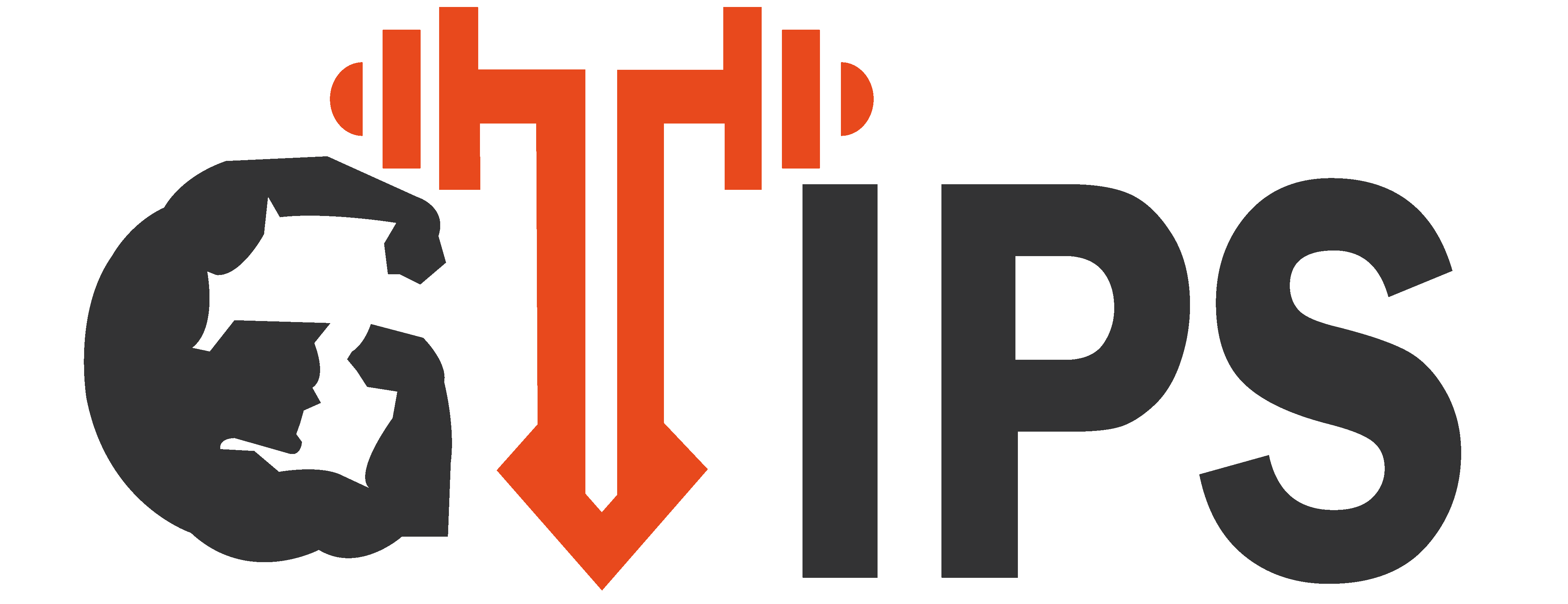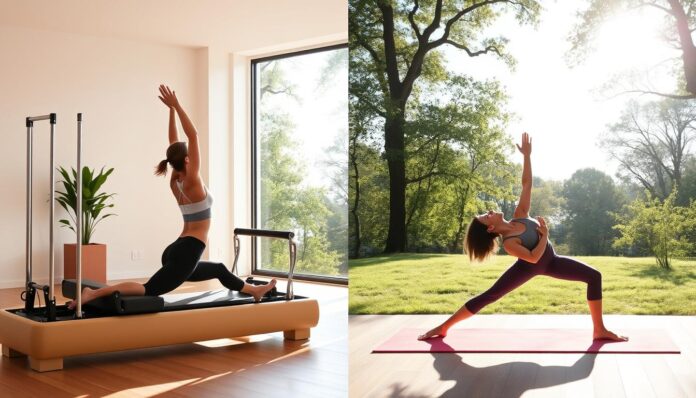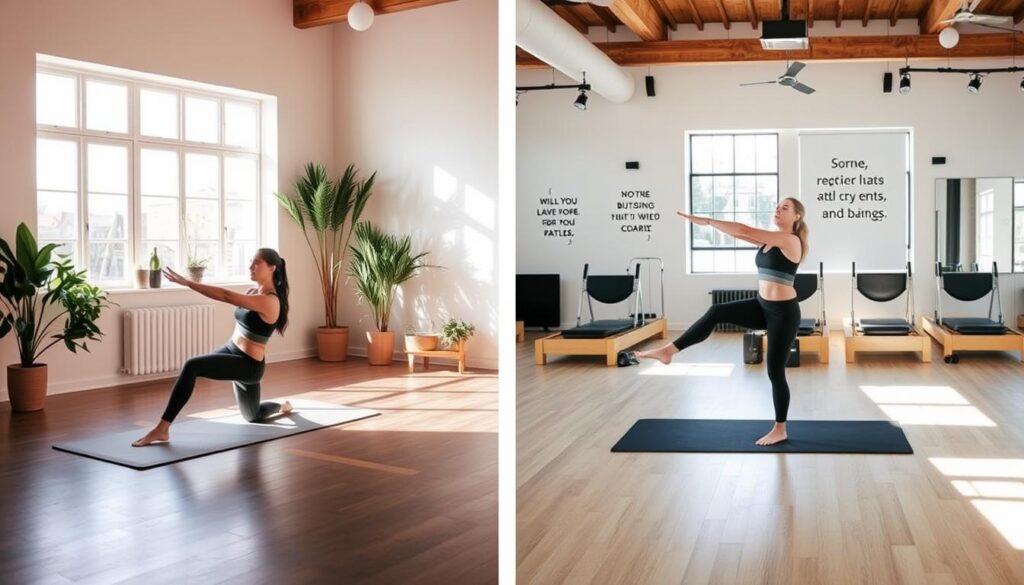Imagine walking into a studio filled with calming scents and soft music. The air is alive with the energy of renewal. You see a group of people, some doing yoga poses, others doing Pilates.
Everyone is laughing and cheering each other on, showing the power of community. But you’re wondering: Which one is better for you? Is it the calm flow of yoga or the precise movements of Pilates? Both are great for keeping fit without putting too much strain on your body.
In this article, we’ll look at what makes Pilates and yoga special. We’ll help you figure out which one is best for your health journey.
Key Takeaways
- Pilates and yoga each offer distinct benefits, enriching overall wellness.
- Many people find it hard to choose between Pilates and yoga because of their different focuses.
- A big number of yoga fans want to boost their overall wellness.
- Pilates helps with healing and easing pain for many conditions.
- Both practices improve flexibility, balance, and mental health.
- Knowing the basics of each can guide you to a better choice.
Understanding the Basics of Pilates and Yoga
Pilates and yoga are two practices that help you reach different fitness goals. Pilates, created by Joseph Pilates in the early 1900s, focuses on controlled movements. It aims to build core strength and stability.
Yoga, with roots over 5,000 years old, combines physical postures, breathing, and meditation. It seeks to improve balance and well-being, making it a holistic fitness approach.
Yoga not only boosts physical strength but also improves mental clarity and reduces stress. Pilates, on the other hand, is great for muscle tone and alignment.
Knowing the basics of Pilates and yoga helps you understand their unique benefits. This knowledge is key to choosing the right practice for your fitness goals.
Common Benefits of Both Practices
Practicing Pilates and yoga brings many benefits for both body and mind. Pilates helps improve posture by strengthening the core. Yoga, on the other hand, focuses on mindfulness and precise movements, boosting body awareness.
Both practices help increase strength and flexibility. They work out different muscle groups like the abs, back, shoulders, and glutes. This helps achieve a leaner body and better mobility.
Stress relief is a big plus for both Pilates and yoga. Yoga uses breathwork and meditation to calm the mind. Pilates, with its focus on posture and technique, can also reduce pain and prevent injuries. Many people find it helps with back pain.
Both Pilates and yoga are easy to start with, needing only a mat. They’re great for people of all ages and fitness levels. This makes them accessible and adaptable to everyone’s needs.
At their core, Pilates and yoga share a focus on mindfulness. This improves self-awareness and mental health. They offer deep stress relief and support a healthier lifestyle.
Pilates Exercises Vs Yoga: Key Differences
Knowing the differences between Pilates and yoga helps you choose the right fitness path. Each has its own roots and focus, shaping how you feel physically and mentally.
Origins and History
Yoga started about 5,000 years ago in ancient India. It was a spiritual practice that aimed to improve flexibility, strength, and mindfulness. Today, yoga has many styles like Vinyasa, Hatha, and Kundalini, all connecting the mind and body.
Pilates began in the early 1900s by Joseph Pilates, a German fitness expert. It’s a modern way to get fit, focusing on muscle tone and body control. Pilates combines rehab techniques with a strong core focus, unlike yoga’s spiritual and flexible sides.
Core Focus vs. Full-Body Balance
Pilates puts a big focus on the Pilates core focus. It builds core strength through controlled movements. This improves body awareness and precise movement control. Pilates workouts often use equipment like the Reformer to enhance body control and core strength.
Yoga, on the other hand, is a full-body workout that includes poses, breathing, and meditation. It boosts flexibility and endurance while promoting mindfulness and stress relief. Unlike Pilates, yoga involves holding poses longer, improving balance and focus in many muscles.
Evaluating Pilates Benefits
Pilates offers many benefits for fitness lovers at all levels. It focuses on precision and control, improving your health and well-being. Let’s see how Pilates helps with strength, rehabilitation, and flexibility.
Building Strength and Endurance
Pilates helps build strength, focusing on the core, back, and hips. It boosts endurance by working out different muscles with controlled movements. Regular Pilates improves muscle stability, helping you perform better in sports and activities.
Rehabilitation and Pain Relief
Pilates is great for rehabbing from joint injuries and other health issues. Its slow movements help ease pain, like back or arthritis. It’s a key part of physical therapy, helping with pain relief and better mobility.
Improving Posture and Flexibility
Pilates is also good for improving your posture. It makes you more aware of your body alignment and movement. This leads to better posture over time. Plus, it enhances flexibility, allowing for more motion. As your core gets stronger, daily activities become easier.
Exploring Yoga Benefits
Yoga brings many benefits, both for your mind and body. It helps you feel more emotionally well by lowering anxiety and stress. Regular yoga practice improves your mental state and physical abilities.
Mental Health and Mindfulness
Yoga and mindfulness go hand in hand. Yoga’s breathing and meditation help you become more aware. This awareness helps you handle stress and emotions better. Over time, you’ll feel more balanced and calm in your daily life.
Increasing Flexibility and Balance
Yoga is great for improving flexibility and balance. By doing different poses, you increase your range of motion and stability. This boosts your physical fitness and makes you more agile in daily activities.
Yoga Poses for Various Fitness Levels
Yoga is for everyone, no matter your fitness level. Start with beginner poses to learn the basics. As you get more confident, try intermediate poses. Adaptive yoga lets everyone join in, with changes for personal needs.
| Benefit | Description | Target Audience |
|---|---|---|
| Mental Health Improvement | Enhances emotional wellness through mindfulness practices. | Individuals looking to manage stress and anxiety. |
| Physical Fitness | Increases yoga flexibility and range of motion. | Athletes and active individuals aiming for better performance. |
| Balance Enhancement | Improves stability and coordination through various poses. | All fitness levels, including seniors needing balance support. |
| Adaptive Yoga | Modifications for injuries or limitations. | Individuals with physical challenges or specific health concerns. |
Making Your Choice: Pilates or Yoga?
Choosing between Pilates and yoga depends on your fitness goals and what you like. Each has its own benefits for personal growth. Knowing what you want to achieve is key to making the right choice.
Considering Your Fitness Goals
If you want to build core strength and improve stability, Pilates might be for you. It focuses on controlled movements to tone muscles and enhance body control. On the other hand, yoga is great for increasing flexibility and improving overall wellness. It emphasizes mindful breathing and flowing postures.
Health Conditions and Modifications
Both Pilates and yoga can be adapted for different health conditions. It’s important to talk to certified instructors. They can adjust exercises to fit your needs, making it safe and effective.
Accessibility and Costs of Classes
Think about the costs and accessibility of classes. Pilates might be pricier due to equipment needs. Yoga, on the other hand, is often more affordable. Many yoga studios offer practices for all levels without needing expensive equipment. This makes yoga a good choice for those on a budget.
Conclusion
Pilates and yoga are both great for fitness and wellness. Pilates, started by Joseph Pilates in the 1920s, focuses on strengthening your core. Yoga, on the other hand, improves flexibility, balance, and mindfulness. Your choice depends on your fitness goals and health.
Both Pilates and yoga offer many benefits for your health. Pilates is known for its precise movements, while yoga is about flowing poses. Adding either to your routine can change your life for the better. Think about what you like and what you want to achieve.
By mixing Pilates and yoga, you can make your workout routine more interesting. Both practices teach you to breathe and be mindful. This helps your mind and heart as much as your body. Pick the right one for you, and start a journey to better health and happiness.
FAQ
What are the main differences between Pilates exercises and yoga?
Pilates focuses on building core strength through controlled movements. Yoga, on the other hand, emphasizes the mind-body connection. It uses poses and deep breathing to promote wellness.
How can Pilates improve my physical strength?
Pilates helps build muscle strength, mainly in the core, back, and hips. It uses precise movements to improve stability and endurance. This can boost your performance in other activities.
What benefits can yoga provide for my mental health?
Yoga helps with mental well-being through mindfulness and deep breathing. It can manage stress and anxiety. Regular practice improves emotional health and balance.
Can I practice Pilates or yoga if I have a specific health condition?
Yes, both Pilates and yoga can be modified for health conditions. It’s important to work with a certified instructor. They can tailor exercises for your needs, ensuring a safe practice.
What equipment do I need for Pilates?
Some Pilates exercises are done on a mat. But, specialized equipment like reformers and resistance bands can enhance your workout. The equipment choice affects the cost and accessibility of Pilates.
How does yoga enhance my flexibility?
Yoga includes poses that target different muscle groups. This increases your range of motion and stability. Regular practice improves flexibility and balance.
Which practice is better for core strength: Pilates or yoga?
Pilates is designed to build core strength through focused movements. Yoga also engages the core but aims to improve flexibility and mindfulness.
Are there types of classes available for beginners in Pilates and yoga?
Yes, both offer beginner classes. Studios provide sessions on foundational techniques. This ensures you can progress safely at your pace.
How do the costs of Pilates classes compare to yoga classes?
Yoga classes are generally more accessible and affordable. Pilates might cost more due to specialized equipment needs.
Can I practice both Pilates and yoga together?
Absolutely! Combining both practices offers core strength from Pilates and flexibility and mindfulness from yoga. This leads to a well-rounded fitness routine.





